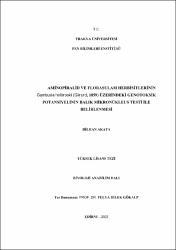Aminopiralid ve Florasulam Herbisitlerinin Gambusia holbrooki (Girard, 1859) üzerindeki genotoksik potansiyelinin balık mikronükleus testi ile belirlenmesi
Özet
Tarım alanlarında yüksek miktarda pestisit kullanımı çevrede toksik maddelerin
birikimine neden olmaktadır. Bu kimyasallar, su kaynakları veya besin zinciri yoluyla
canlılara ulaşabilmektedir. Trakya bölgesinde tahıl üretiminde yüksek oranda herbisit
kullanılmaktadır. Bu çalışmada, Aminopiralid ve Florasulam etken maddeleri ve ticari
formülasyonunun balık mikronükleus (MN) testi kullanılarak sitotoksik ve genotoksik
ön değerlendirmesinin yapılması amaçlanmıştır. Ticari formülasyonun ön çalışma ile
belirlenen 72 saat LC50
değerinin katlar halinde (1/2, 1/4, 1/8) azalan konsantrasyonları
(150 mg/L, 75 mg/L, 37,5mg/L LC50
), etken madde Aminopiralid ve Florasulam’ın 1/4
LC50
konsantrasyonu (25 mg/L) 24, 48, 72 saat sürelerle Gambusia holbrooki üzerinde
muamele edilerek, kan eritrositlerinde mikronükleus (MN), eritrosit nükleer
anormallikler (ENA) ve polikromatik eritrosit (PCE) frekansı saptanmıştır.
Eritrosit Nükleer Anormallikler (ENA); çentik, lob, MN, tomurcuk, binükleuslu
(BN) hücre frekansları saptanmıştır. Ticari formülasyon ve etken maddelerin balık
eritrosit testinde gözlenen anormalliklerin süreye bağlı olarak artış gösterdiği, 48 ve 72
saat muameleler sonrası tüm anormalliklerde kontrole göre anlamlı artış olduğu tespit
edilmiştir. Aminopiralid ve Florasulam’ın 25 mg/L, 24, 48, 72 saat muamelesi sonrası
olgun eritrosit sayısı (normakromatid eritrosit = NCE) azalarak, dolaşıma yeni katılan
PCE sayısı arttığı saptanmıştır. Genotoksisite belirteçlerinden olan nükleer
anormalliklerin (NA) 72 saat sürede arttığı görülüyorken, hücre savunma mekanizması
gereği muhtemel solunum stresi nedeniyle eritrosit sayısının yükselmesinden kaynaklan
PCE frekansının arttığı tespit edilmiştir. Sonuç olarak NA’ların konsantrasyona bağlı
artışı Aminopiralid ve Florasulam pestisitinin potansiyel genotoksik etkisinin
bulunduğunu göstermektedir. The use of high amounts of pesticides in agricultural areas causes the
accumulation of toxic substances in the environment. These chemicals reach natural
habitats through water sources and food chain. High rates of herbicides are used in grain
production in the ’’ Thrace’’ region of Turkey. In this study, it was aimed to evaluate
the cytotoxic and genotoxic potential effects of Aminopyralid and Florasulam active
ingredients and their commercial formulation on fish by using micronucleus test.
Erythrocyte Nuclear Abnormalities (ENA); Notch, lobe, micronucleus, bud, binucleated
cell frequencies were determined. Commercial formulation and its active
ingredients induced nuclear abnormallities in fish erythrocytes, there was a significant
increase in all abnormalities compared to the control group. After 25 mg/L, 24, 48, 72
hours treatment of Aminopyralid and Florasulam, it was determined that the number of
mature erythrocytes (NCE=Normachromatid Erythrocyte) were decreased, and the
number of PCE (Polychromatic erythrocyte) which were newly added to the circulation
were increased. While it was observed that nuclear abnormalities, one of the markers of
genotoxicity, were increased in 72 hours exposure period and it was determined that the
PCE frequency were increased as the increase in the number of erythrocytes due to
possible respiratory stress of cell defense mechanism. In conclusion, concentrationdependent
increase
in
nuclear
abnormalities
confirms
that
the
pesticides
Aminopyralid
and
Florasulam
have
potential
genotoxic
effects.
Koleksiyonlar
- Tez Koleksiyonu [1287]


















